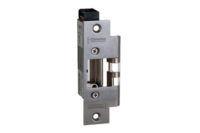
Properly and efficiently installing magnetic locks and strikes takes skill, experience and craftsmanship. From selecting the correct lock for the project (and the door) all the way to testing the installation and leaving the customer pleased and well-informed, there are definite do’s and don’ts that will make the difference between frustration and satisfaction.
“First there is the planning stage, making sure you have a good plan,” relates Greg Miskulin, sales engineer, Security Corp., Novi, Mich. “Then there is the actual process of the cutting and drilling and mounting of the device. That would also include connecting the wiring to power the lock. The actual installation would include attaching the magnetic lock or strike to the door. After that you have the testing phase where you energize the lock to make sure it will function and keep the door secure.”
Each step of the process provides an opportunity for either helping or hindering the job. Here, manufacturers and security installers offer their best advice for a smooth installation.
CHOOSING THE RIGHT PRODUCT
It doesn’t matter how good an installer you have if the product is the wrong one for the door or application.
“The first thing you have to ask yourself is ‘what is the objective of adding this electrified device to the door?’” says John Hunepohl, director of education, Assa Abloy, New Haven, Conn. “Is it for traffic control? High-security monitoring? What is the security objective?”
Miskulin agrees that is the first step. “The first consideration is going to be the type of security the customer is looking for,” he believes. “Magnetic locks are generally considered higher security than electric strikes because strikes still allow you to gain entry with a key, whereas magnetic locks do not.”
In addition, magnetic locks offer more options than electric strikes, adds Bob Schnarr, technical training instructor, Rutherford Controls, Cambridge, Ontario. “Electric strikes are great for where you want to control a door, but are not worried about stopping someone from leaving,” he explains. “Magnetic locks will stop someone from coming or going.”
Beyond security concerns, there are other factors that may help determine the type of lock you need to use.
“It’s all about the wall construction, door frame construction and door construction,” says Mark Grossman, vice president and general manager, ASG Security, Beltsville, Md. “Those are the three things that will dictate what type of locks you should use.
“A magnetic lock is typically used in applications where the construction of the door makes it difficult to get wires within the door frame to an electric strike. Electric strikes are often used on internal doors because they usually have drywall framed construction and hollow frames that allow you to more easily fish a wire into the frame and get it to the electric strike,” he says.
Magnetic locks are often ideal for glass-front doors, doors with cinderblock surrounding them, and doors that have concrete-filled aluminum frames.
But there are situations that prohibit magnetic locks as well, making electric strikes a better choice.
“In a lot of municipalities, the Authority Having Jurisdiction (AHJ) may not allow magnetic locks for safety reasons,” Miskulin says.
Marilyn Collins, marketing business development manager, Schlage Commercial Electronic Security, Ingersoll Rand Security Technologies, Carmel, Ind., explains. “The AHJs have various requirements for egress, fire and other building codes. It’s important to check which codes apply.”
PREPARING YOUR SITE
Once you have chosen either a magnetic lock or an electric strike, the next step is to make sure the door is ready to receive the lock and that you have all of the instructions and tools necessary for the job.
“Always check the condition of the door in advance,” says Andy Jeremiah, product manager, Schlage Commercial Electronic Security, Ingersoll Rand Security Technologies. “You want to make sure it closes properly – that it doesn’t jam. Many times the door itself has to be addressed before you put any lock on there.”
More specifically, Schnarr says, “Make sure the hinges work, the door is not sagging. When it comes to pulling in the wires, make sure the mounting power supply is in the appropriate area and that the wire runs are large enough for the distance you are running them.”
Another thing to check if you are using electric strikes is what type of locking hardware is on the existing door, Hunepohl advises. “The electric strike that will work for a cylindrical lock won’t work for a mortise lock or panic bars. You have to know what type of lock you have there to pick the right electric strike.”
If you are going with a magnetic lock, make sure you have all the necessary hardware required for that installation, Miskulin adds. “For example, there may be some additional brackets to mount the mag lock at that type of door. There are egress devices that are required when you have a magnetic lock. Often you have to integrate with the fire alarm system to provide emergency egress. These are all things to prepare for.”
Door considerations for mag locks include thickness for both the door and frame and the door stop, Grossman adds. “With magnetic locks, the dimensions of the door frames and stops are critical. Magnetic locks come in a standard pack that in most applications the mag lock will mount without any extra accessories. But spacer bars, aluminum bars that fill the gaps and create a solid surface, may be needed.”
In addition, always check with your AHJ prior to doing any work to make sure you have the proper permits that may be required.
INSTALLING THE LOCK
Both magnetic locks and electric strikes typically take an average of an hour to an hour-and-a-half for one technician to install (assuming no problems). The time for a magnetic lock installation can increase if you factor in other hardware that needs to be included. In addition to the standard tools, there are some specialized tools that come in handy, depending on the type of lock. These may include a Sawzall, a Dremel, painters tape, wire cutters and strippers and heavier-duty screws and nuts.
Installing an electric strike involves actually cutting into the doorframe. “We teach them to prepare by using painter’s tape,” Hunepohl says. “Wherever you are going to cut, put painters tape over it and draw your cut lines on that. You are less likely to knick things up that way.”
After that, electric strikes are fairly straightforward, Schnarr says. “All you are going to do is notch the frame to accommodate the lip bracket. Often steel frames have a welded box in them that you may have to knock out to accommodate the strike. Mark the base of the frame, make three cuts on the face of the frame (using a jigsaw or Sawzall) for the lip bracket, then just take the wires in the frame and hook them up to the electric strike.”
A Dremel or a file should be used to clean up the rough hole so the strike sits properly and there are no rough edges to catch the wire.
For magnetic locks, there is no cutting, but there are more steps involved. Most magnetic locks come with a template, so that is the first step.
“You are going to apply the template following the instructions, secure it to the door with adhesive and drill all the required holes,” Jeremiah explains. “There is some drilling required on the frame and some on the door. The armature then gets mounted to the door. Make sure you run all the wires to the frame and poke them out the hole you just drilled. Secure the mounting bracket for the magnet on the frame, then install the magnet to the mounting bracket, test and tighten it. Then make the final electrical connections.”
Hunepohl recommends using heavier gauge hardware if the door is too light. “Don’t take ¾-inch screws that come in the box if that is not appropriate for the door. I have seen some very poor magnetic lock installations where you look at the hollow metal doors and frames and they simply don’t have enough ‘meat’ to them to support the screws,” he says. “But if you use a blind nut that is expanded by turning the screw, then you make yourself a very strong connection that is going to hold.”
A CLEAN FINISH
Finally, once you are done with the installation make sure you do all the proper testing, explaining and cleaning up.
Grossman recommends two types of tests. “Before we hook the wires up, we put direct power to the lock and make sure that it functions without any other influences. Then we make the connections to the controlling system and do another functional test. That way when we hook everything up and it doesn’t work, we can tell if it is the lock or the system.”
Schnarr adds that it is important to make sure the customer is informed about how to use the new lock. “To me, it is important to make sure that everything functions according to the manufacturer’s and customer’s specification. Make sure the access control system is programmed properly, and that when you leave the customer is properly trained on how to use it and has all the user’s manuals and programming required for a complete access control system.”
Finally, it is important to make sure the door is working mechanically before you leave, Hunepohl says. But it is equally important to leave with a good impression. “When you are all finished, clean up and make sure it looks like that lock has always been there. Make it look professional.”
SIDEBAR: Troubleshooting the Lock
Installing the lock is not always as simple as it seems. There are some common pitfalls and mistakes that can run an installer into trouble.
A concrete-filled aluminum frame, for example, can be an unpleasant surprise on an electric strike installation.
“Some of the problems and pitfalls arise with not knowing what is on the other side of that drill bit,” relates John Hunepohl, director of education at Assa Abloy. “What if that hollow metal frame is filled with cement? You didn’t realize you needed masonry tools and now your installation is going to take much longer.”
Sometimes it isn’t what has been done to the frame as much as where it is located, says Mark Grossman, vice president and general manager at ASG Security. “There may be a lock body that you don’t see, or it happens that you cut into a frame and find a stud of cinderblock. That is typically why techs will call in and say they have the wrong parts.”
Another potential pitfall with electric strikes is not cleaning up the cuts before running the wiring. “They need to be careful when prepping the frame and pulling wire that there are no burrs or sharp metal pieces in the frame body. Some installers will pull this stuff and strip a wire and cause a ground fault.”
Alignment can be an issue for both magnetic locks and strikes, so making sure it aligns properly is critical.
Andy Jeremiah, product manager at Schlage Commercial Electronic Security, Ingersoll Rand Security Technologies, says this can be more complex for the magnetic lock, however. “It is important with the mag locks to make sure the armature ‘floats,’ that it isn’t held tight against the door.”
Bob Schnarr, technical training instructor at Rutherford Controls, has seen this occur frequently. “It needs to be aligned properly to come into full contact for the full holding force. The problem comes when you get a call saying the magnet will hold a screwdriver but won’t lock the door. Then you know they have over-tightened or misaligned the armature and it can’t draw flush with the face of the mag lock. If you loosen the center bolt, all of a sudden the door locks without a problem.”
SIDEBAR: Tips for a Smoother Installation
While the specifics of each installation vary widely depending on the type of lock, door and customer, there are some tips that are universal and can help an installation go as easily as possible:- “An ounce of prevention goes a long way. Access manufacturer documentation and installation tips before the installation” – Marilyn Collins, Ingersoll Rand Security Technologies
- “Have the right tools. If you need a hammer, get a hammer. Put some craftsmanship into your installation. – John Hunepohl, Assa Abloy
- “Be familiar with the customer requirements and quote it properly in the first place.” – Bob Schnarr, Rutherford Controls
- “Survey the job site ahead of time and take precise measurements of doors, walls and frames. – Mark Grossman, ASG Security
- “It comes down to installers having experience and technique and knowing what they are doing. If you use all those things, you are generally going to have a good installation.” – Greg Miskulin, Security Corp.






